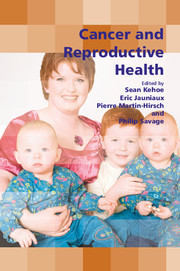Book contents
- Frontmatter
- Contents
- Participants
- Preface
- SECTION 1 Epidemiology, Genetics and Basic Principles of Chemotherapy and Radiotherapy
- 1 Epidemiology of cancer in women during reproductive life
- 2 Cancer genetics and reproduction
- 3 Chemotherapy in the treatment of pregnant women with cancer
- 4 Radiotherapy and cancer
- SECTION 2 Fertility Issues and Paediatric Cancers
- SECTION 3 Gynaecological Cancers and Precancer
- SECTION 4 Diagnostic Dilemmas
- SECTION 5 The Placenta
- SECTION 6 Non-Gynaecological Cancers
- SECTION 7 Multidisciplinary Care and Service Provision
- SECTION 8 Consensus Views
- Index
3 - Chemotherapy in the treatment of pregnant women with cancer
from SECTION 1 - Epidemiology, Genetics and Basic Principles of Chemotherapy and Radiotherapy
Published online by Cambridge University Press: 05 October 2014
- Frontmatter
- Contents
- Participants
- Preface
- SECTION 1 Epidemiology, Genetics and Basic Principles of Chemotherapy and Radiotherapy
- 1 Epidemiology of cancer in women during reproductive life
- 2 Cancer genetics and reproduction
- 3 Chemotherapy in the treatment of pregnant women with cancer
- 4 Radiotherapy and cancer
- SECTION 2 Fertility Issues and Paediatric Cancers
- SECTION 3 Gynaecological Cancers and Precancer
- SECTION 4 Diagnostic Dilemmas
- SECTION 5 The Placenta
- SECTION 6 Non-Gynaecological Cancers
- SECTION 7 Multidisciplinary Care and Service Provision
- SECTION 8 Consensus Views
- Index
Summary
Introduction
A malignancy is currently diagnosed in approximately 1 per 1000 pregnant women and, as women delay pregnancy to older maternal ages, physicians can expect to increasingly encounter the difficult dilemma of managing cancer during pregnancy. The most common malignancies occurring in pregnant women are breast cancer, lymphoma and melanoma. It is estimated that 7—14% of premenopausal breast cancers occur in pregnancy and 3% of women with Hodgkin's disease are pregnant at diagnosis.
A number of key issues must be considered regarding the treatment of a malignancy in pregnancy. The decision on whether or not to use chemotherapy must take into account the effect of a treatment delay on maternal survival, and the benefits of maternal treatment during pregnancy must be weighed against the fetal risks from in utero treatment exposure.
There is a lack of data to help make these difficult decisions. To date, 447 reports of women receiving chemotherapy during pregnancy have been published: 343 have previously been summarised in a review in Lancet Oncology. These and the 104 additional cases published since that review are described in this chapter.
Chemotherapy, teratogenicity and gestational age
The potential teratogenicity of a drug is dependent on the fetal stage of development at exposure, the dosage and the characteristics that affect placental transfer. High lipid solubility, low molecular weight, non-ionisation and loose binding to plasma proteins favour transfer of drug from mother to fetus.
Keywords
- Type
- Chapter
- Information
- Cancer and Reproductive Health , pp. 23 - 54Publisher: Cambridge University PressPrint publication year: 2008
- 1
- Cited by

